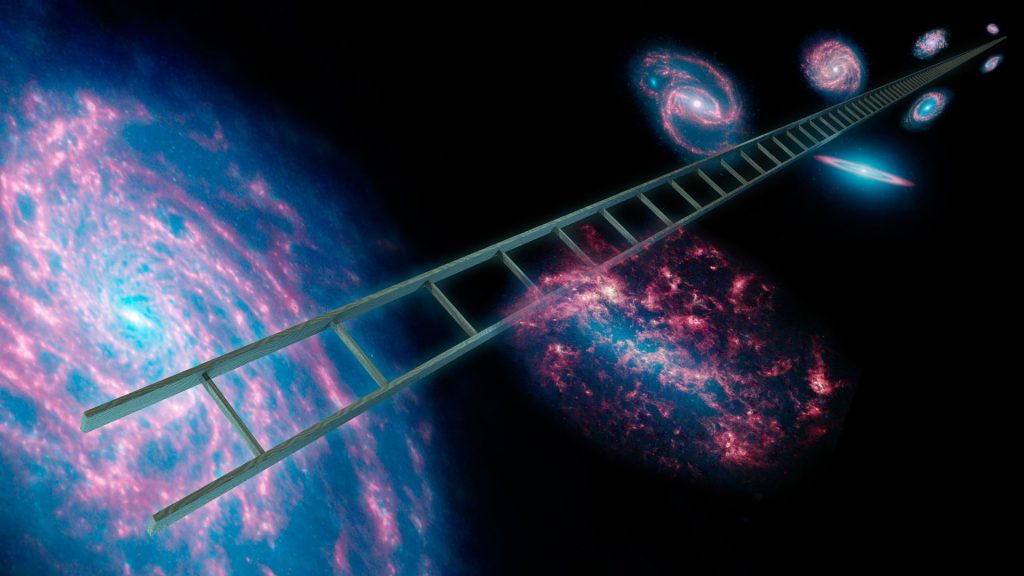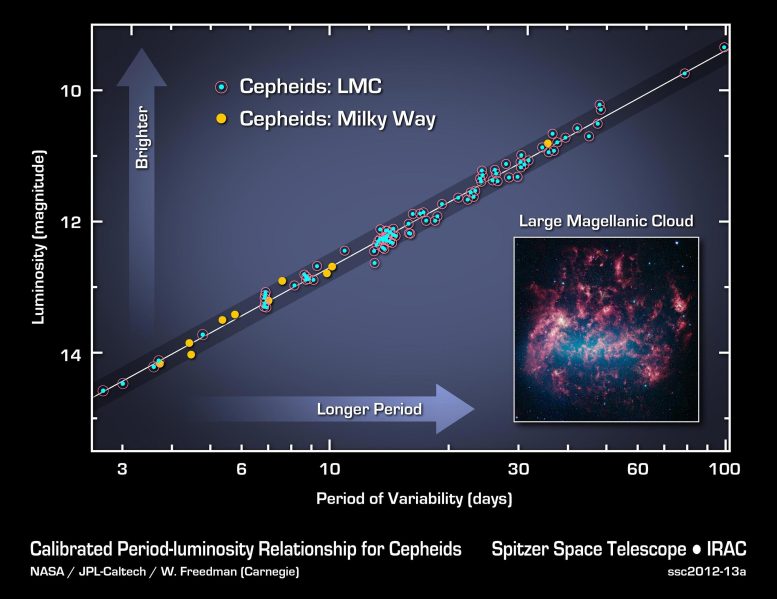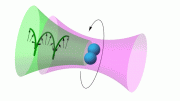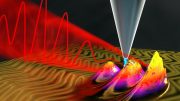
The cosmic distance ladder, symbolically shown here in this artist’s concept, is a series of stars and other objects within galaxies that have known distances. Credit: NASA/JPL-Caltech
Using NASA’s Spitzer Space Telescope, astronomers have greatly improved the cosmic distance ladder used to measure the expansion rate of the universe, as well as its size and age, placing the newly refined value for the Hubble constant at 74.3 plus or minus 2.1 kilometers per second per megaparsec.
Astronomers using NASA’s Spitzer Space Telescope have announced the most precise measurement yet of the Hubble constant, or the rate at which our universe is stretching apart.
The Hubble constant is named after the astronomer Edwin P. Hubble, who astonished the world in the 1920s by confirming our universe has been expanding since it exploded into being 13.7 billion years ago. In the late 1990s, astronomers discovered the expansion is accelerating, or speeding up over time. Determining the expansion rate is critical for understanding the age and size of the universe.
Unlike NASA’s Hubble Space Telescope, which views the cosmos in visible light, Spitzer took advantage of long-wavelength infrared light to make its new measurement. It improves by a factor of 3 on a similar, seminal study from the Hubble telescope and brings the uncertainty down to 3 percent, a giant leap in accuracy for cosmological measurements. The newly refined value for the Hubble constant is 74.3 plus or minus 2.1 kilometers per second per megaparsec. A megaparsec is roughly 3 million light-years.

This graph illustrates the Cepheid period-luminosity relationship, which scientists use to calculate the size, age, and expansion rate of the universe. The data shown are from NASA’s Spitzer Space Telescope, which has made the most precise measurements yet of the universe’s expansion rate by recalculating the distance to pulsating stars called Cepheids. Credit: NASA/JPL-Caltech
“Spitzer is yet again doing science beyond what it was designed to do,” said project scientist Michael Werner at NASA’s Jet Propulsion Laboratory in Pasadena, California. Werner has worked on the mission since its early concept phase more than 30 years ago. “First, Spitzer surprised us with its pioneering ability to study exoplanet atmospheres,” said Werner, “and now, in the mission’s later years, it has become a valuable cosmology tool.”
In addition, the findings were combined with published data from NASA’s Wilkinson Microwave Anisotropy Probe to obtain an independent measurement of dark energy, one of the greatest mysteries of our cosmos. Dark energy is thought to be winning a battle against gravity, pulling the fabric of the universe apart. Research based on this acceleration garnered researchers the 2011 Nobel Prize in physics.
“This is a huge puzzle,” said the lead author of the new study, Wendy Freedman of the Observatories of the Carnegie Institution for Science in Pasadena. “It’s exciting that we were able to use Spitzer to tackle fundamental problems in cosmology: the precise rate at which the universe is expanding at the current time, as well as measuring the amount of dark energy in the universe from another angle.” Freedman led the groundbreaking Hubble Space Telescope study that earlier had measured the Hubble constant.
Glenn Wahlgren, Spitzer program scientist at NASA Headquarters in Washington, said infrared vision, which sees through dust to provide better views of variable stars called cepheids, enabled Spitzer to improve on past measurements of the Hubble constant.
“These pulsating stars are vital rungs in what astronomers call the cosmic distance ladder: a set of objects with known distances that, when combined with the speeds at which the objects are moving away from us, reveal the expansion rate of the universe,” said Wahlgren.
Cepheids are crucial to the calculations because their distances from Earth can be measured readily. In 1908, Henrietta Leavitt discovered these stars pulse at a rate directly related to their intrinsic brightness.
To visualize why this is important, imagine someone walking away from you while carrying a candle. The farther the candle traveled, the more it would dim. Its apparent brightness would reveal the distance. The same principle applies to cepheids, standard candles in our cosmos. By measuring how bright they appear on the sky, and comparing this to their known brightness as if they were close up, astronomers can calculate their distance from Earth.
Spitzer observed 10 cepheids in our own Milky Way galaxy and 80 in a nearby neighboring galaxy called the Large Magellanic Cloud. Without the cosmic dust blocking their view, the Spitzer research team was able to obtain more precise measurements of the stars’ apparent brightness, and thus their distances. These data opened the way for a new and improved estimate of our universe’s expansion rate.
“Just over a decade ago, using the words ‘precision’ and ‘cosmology’ in the same sentence was not possible, and the size and age of the universe was not known to better than a factor of two,” said Freedman. “Now we are talking about accuracies of a few percent. It is quite extraordinary.”
The study appears in the Astrophysical Journal. Freedman’s co-authors are Barry Madore, Victoria Scowcroft, Chris Burns, Andy Monson, S. Eric Person and Mark Seibert of the Observatories of the Carnegie Institution and Jane Rigby of NASA’s Goddard Space Flight Center in Greenbelt, Maryland.
Reference: “Carnegie Hubble Program: A Mid-Infrared Calibration of the Hubble Constant” by Wendy L. Freedman, Barry F. Madore, Victoria Scowcroft, Chris Burns, Andy Monson, S. Eric Persson, Mark Seibert and Jane Rigby, 21 September 2012, Astrophysical Journal.
DOI: 10.1088/0004-637X/758/1/24









The evidence of the universe’s rate of expansion indicates to me that it is slowing down, not accelerating. Let me explain.
The basic premise of the accelerating expansion theory is that the further an object is from us, the faster we and it are moving away from each other; closer objects separate more slowly and distant objects separate more rapidly. Thus, objects move progressively faster (i.e., they accelerate) as they move apart: speed is a function of distance and the expansion of the universe is accelerating.
However, the light emanating from closer objects (the “slow” ones) is relatively new while the light coming from more distant objects (the “fast” ones) is relatively old. As we look progressively deeper into the universe we are seeing progressively older objects and the data we collect from them is correspondingly older than data taken from closer objects. The conclusion I draw from this is that the universe was expanding rapidly when the oldest, most distant data was generated while the newer data indicate more recent, slower speeds. I therefore contend that celestial speeds are a function of age, not of distance, and that the expansion of the universe is decelerating.
What am I missing?
Sorry dear. The universe is always expanding and that too it is a geometric expansiion fitting a paraboloid in expansion. The article speaks of refined method of more accurately calculating distances of galaxies compared to optical candle method. Here 10 cepheids in our Milky way galaxy and 80 cepheids in the neighbouring Large Megallinic Cloud is taken as candle. The advantage is that they are all infra-red objects which is not obscured by galactic dust to tone down the calculations of candle brightness measurement. Since Universe is interspersed with mysterious Dark Matter and all pervading Dark Energy which are 96 percent of the component of Universe, the impetus for galactic velocity is given by them at astonishing force. They are all anti-gravitational in force.Dstk Matter and Dark Energy are subjects that cannot be dispensed with in view of strong proof through gravitational lensing methods of distant galaxies. A refined method of calculating distances cannot be taken for granted for demolishing the theory. How else you will explain Doppler attenuation of original Cosmic Ray backround into the present microwave backround calld CMB? Gravitation is playing only a minor role in the Universe and the major share has been taken by the forces of Dark Matter and Dark Energy. In the line of Galeleos words of “and still it goes on” I can modify it as ” and still it accelerates”. This article should not be misinterpreted. Thank You.
I’m no astronomer, so please forgive my ignorance, but in my previous post I was not trying to interpret the above article. Rather I am asking what seems to me to be a very basic question. I am trying to understand how we reconcile the notion of an accelerating expansion of the universe with observations that seem to suggest the opposite. The oldest observations of celestial objects (those that are farthest away from us) reveal separation speeds 13 billion years ago that were faster than the more recent data observed from closer objects. Forgetting about cephids, dark matter and parabolas for a moment, if objects were moving more rapidly long ago than they were in the more recent past, is it not logical to conclude that the expansion is decelerataing?
Edwin Hubble did not believe in the expanding universe. see his article
http:nimble.nimblebrain.net/hubblepaper.html
THE PROBLEM OF THE EXPANDING UNIVERSE
All physicists should read this article.
See the alternative to the expanding universe, Quaternion Physics
amenusa.wordpress.com/article/edwin-hubbles-the-problem-of-the-expanding-universe/
There is now a very simple way to calculate Hubble’s Constant, by inputting to an equation, the numerical value of Pi and the speed of light (C) from Maxwell’s equations, and the value of a parsec. NO space probe measurements (with their inevitable small measuring / interpretation errors) are now required. Hubble’s Constant is ‘fixed’ at 70.98047 PRECISELY. This maths method removes the errors / tolerances that is always a part of attempting to measuring something as ‘elusive’ as Hubble’s Constant. This has very deep implications for theoretical cosmology.
The reciprocal of ‘fixed’ 70.98047 is 13.778 billion light years, BUT as this does not increase as time passes, it’s the Hubble distance ONLY.
The equation to perform this is :- 2 X a meg parsec X light speed (C). This total is then divided by Pi to the power of 21. This gives 70.98047 kilometres per sec per meg parsec.
The equation to perform this can also be found in ‘The Principle of Astrogeometry’ on Amazon Kindle Books. This also explains how the Hubble 70.98047 ‘fixing’ equation was found. David.